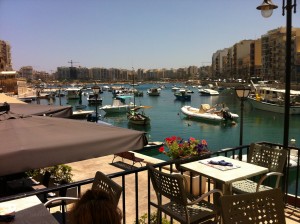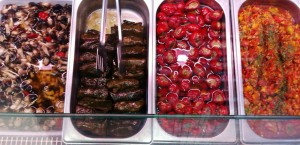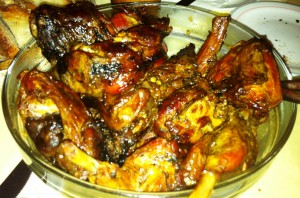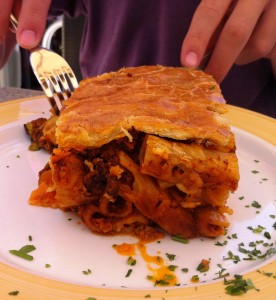Part 2
 Malta, like it’s nearest neighbour Sicily, has an indigenous cuisine that has been heavily flavoured by Italy and North Africa, but has also been seasoned by the various foreign powers who have raided or relocated to Malta over the centuries, including the Arabs, the Spanish and the English. Our hospitable hostess was keen for us to try everything: local snacks and specialties; home cooking; fine dining, we sampled it all. Our first port of call, however, mere moments off the ferry, was the local supermarket.
Malta, like it’s nearest neighbour Sicily, has an indigenous cuisine that has been heavily flavoured by Italy and North Africa, but has also been seasoned by the various foreign powers who have raided or relocated to Malta over the centuries, including the Arabs, the Spanish and the English. Our hospitable hostess was keen for us to try everything: local snacks and specialties; home cooking; fine dining, we sampled it all. Our first port of call, however, mere moments off the ferry, was the local supermarket.
Used to the heavy American presence on Manila’s supermarket shelves, we were initially surprised to find our favourite English chocolates, biscuits and breakfast cereals in residence, until we learned that the English had a prominent role in Malta for almost a century, and continue to visit regularly. We tossed in a packet of Penguins for the kids,  but for me, the best part of any supermarket is the delicatessen counter. The one in St. Paul’s Bay was irresistible, and we selected a ridiculous amount of antipasti. We were keen to try everything. We found some old favourites like dolmades, but we also made a point of choosing a number of Maltese delicacies: stuffed olives; Bigilla (a thick dip made from broad beans and garlic), and Gbejniet which is a small round Gozitan goat’s cheese served with traditional Maltese crackers called galleti. These are thin, hard and brittle, quite a different texture from the delicious soft rolls called hobz or ftira, a ring shaped loaf of similar consistency to the Italian ciabatta, but with a harder crust.
but for me, the best part of any supermarket is the delicatessen counter. The one in St. Paul’s Bay was irresistible, and we selected a ridiculous amount of antipasti. We were keen to try everything. We found some old favourites like dolmades, but we also made a point of choosing a number of Maltese delicacies: stuffed olives; Bigilla (a thick dip made from broad beans and garlic), and Gbejniet which is a small round Gozitan goat’s cheese served with traditional Maltese crackers called galleti. These are thin, hard and brittle, quite a different texture from the delicious soft rolls called hobz or ftira, a ring shaped loaf of similar consistency to the Italian ciabatta, but with a harder crust.
Our Maltese/Australian hostess had previously taught me how to make kapunata, a Maltese ratatouille, is now a firm favourite in our household. ‘My grandmother’s recipe’ she tell me, ‘uses aubergine (eggplant) , onions, red and green peppers and zucchini… with tomatoes, capers and olive, [but] it should not be confused with a pepperonata,’ she advises, ‘this is an Italian dish that the Maltese make too, but it contains only red , yellow and green capsicum and sometimes onions.’ Our first night in Malta, she treated us to another of her wonderful pasta dishes: a simple spaghetti pomodoro with garlic and basil that was quite possibly the best meal I had eaten in weeks.
 The second night, we drove down the road to Charlie’s Inn, for a feast starring the local speciality il-fenkata, rabbit stew made with red wine and flavored with herbs. Fenek (rabbit) has been a culinary tradition in Malta for centuries. The Knights of Malta uncharitably prevented the Maltese from poaching wild rabbits, so now they eat as many as they can catch or breed. We started with a delicious rabbit sauce with piselli (peas) served on pasta, followed by pan fried rabbit with oil and garlic.
The second night, we drove down the road to Charlie’s Inn, for a feast starring the local speciality il-fenkata, rabbit stew made with red wine and flavored with herbs. Fenek (rabbit) has been a culinary tradition in Malta for centuries. The Knights of Malta uncharitably prevented the Maltese from poaching wild rabbits, so now they eat as many as they can catch or breed. We started with a delicious rabbit sauce with piselli (peas) served on pasta, followed by pan fried rabbit with oil and garlic.
On the third day we lunched beside a gorgeous little harbour called Spinola Bay. Speed boats, dinghies and sailing boats bobbed on lapis lazuli waters. At Café Rafael, we sat on a broad terrace overlooking the bay, surrounded by baskets of red petunias and shaded from the hot midday sun by a huge umbrella. As we soaked up the view, and the midday sun sparkled on the water, plates of salmon and zucchini pasta and calamari fritti were consumed with enthusiasm. More interesting,  however, were the Maltese specialties: timpana, a pasta bake of macaroni, minced beef and pork, eggs, cheese, chicken liver and bacon topped with pastry; and the stuffed squid. In many Mediterranean countries squid is commonly sliced into rings, fried, and served with lemon. The Maltese love to stuff the squid with onion and garlic, tomatoes and a glass of wine, diced bread, capers, prawns and herbs, before simmering it in a spicy tomato sauce. Over-indulgence indeed.
however, were the Maltese specialties: timpana, a pasta bake of macaroni, minced beef and pork, eggs, cheese, chicken liver and bacon topped with pastry; and the stuffed squid. In many Mediterranean countries squid is commonly sliced into rings, fried, and served with lemon. The Maltese love to stuff the squid with onion and garlic, tomatoes and a glass of wine, diced bread, capers, prawns and herbs, before simmering it in a spicy tomato sauce. Over-indulgence indeed.
During the in-between-times, we snacked. In Malta, there are a myriad street stalls and tapas-style bars selling a range of traditional morsels, and we had three days to try as many as possible. Hobz Biz-Zejt – and yes, I have to admit I have no idea how to pronounce it either – makes a wonderful snack, brunch or lunch. Brush a piece of bread with olive oil and top it with ripe and roughly chopped tomatoes, onions and herbs, tuna, white broad beans and capers, and you have a tasty, traditional snack. Once a humble dish, these days it has become very trendy and you can find it served in many smart restaurants as an appetizer. In Spain,without the added extras of beans, tuna and capers, it is breakfast. In Italy, bruschetta bears a family resemblance.
Pastizzi provide another easy mouthful en route to the next Church or viewpoint. Diamond-shaped, flaky pastry parcels filled with ricotta or mushy peas, pastizzi are the perfect merienda, distantly related to empanada, only lighter, and eaten hot. For those with a sweeter tooth, mqaret are pastry parcels filled with a thick, rich date mixture and then deep fried. They make a sumptuous mouthful, but be warned, they are addictive – and fattening.
Anyone feeling hungry? Me too. See you in the kitchen, chopping tomatoes…
